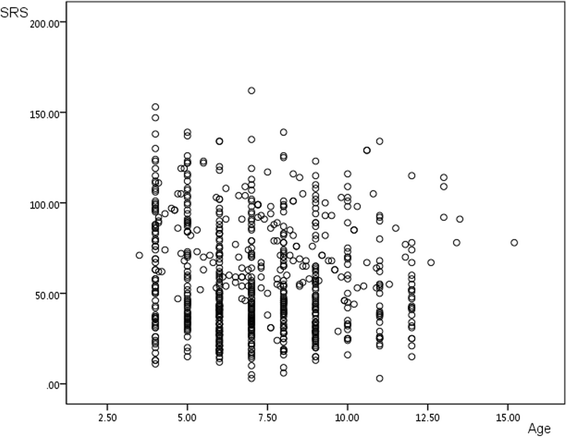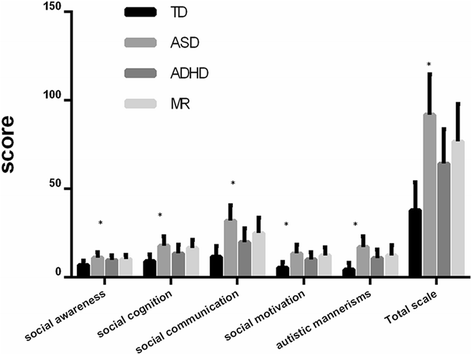Investigating the validation of the Chinese Mandarin version of the Social Responsiveness Scale in a Mainland China child population
- PMID: 28166747
- PMCID: PMC5292795
- DOI: 10.1186/s12888-016-1185-y
Investigating the validation of the Chinese Mandarin version of the Social Responsiveness Scale in a Mainland China child population
Abstract
Background: Researchers from several different countries have found the Social Responsiveness Scale (SRS) to have good psychometric properties. However, to our knowledge, no studies on this subject have been reported in Mainland China. In this study, we investigated the psychometric properties of the Chinese Mandarin version of the SRS when used in Mainland China.
Methods: The reliability and validity of the parent-report SRS in a sample of 749 children of 4- to 14-year-olds: 411 typically developing and 338 clinical participants (202 with autism spectrum disorder (ASD)) were examined.
Results: Internal consistency for total scale (0.871-0.922), test-retest reliability (0.81-0.94), and convergent validity with the Autism Behavior Checklist (ABC) (0.302-0.647) were satisfactory. The SRS total score discriminated between the ASD and other developmental disorders. Receiver operating characteristic (ROC) analyses revealed that the SRS was predicted to accurately classify 69.2-97.2% of youth ASD. Exploratory factor analysis (EFA) supported a single-factor solution for the ASD subsample. Confirmatory factor analysis (CFA) did not confirm the theoretical construct of five factors model with inadequate fit in the ASD subsample.
Conclusions: Overall, our findings supported the reliability and validity of the parent-report SRS as one ASD screening instrument. In addition, we also suggest that the use of separate cut-offs for screening purposes (optimizing sensitivity) vs. clinical confirmation (optimizing specificity) should be considered.
Keywords: Autism spectrum disorder; Chinese version; Reliability; Social Responsiveness Scale; Validity.
Figures




Similar articles
-
Investigating and comparing the psychometric properties of the Chinese Mandarin version of social responsiveness scale-2 and its shortened version in preschool-age children with autism spectrum disorder.Asian J Psychiatr. 2023 Jan;79:103395. doi: 10.1016/j.ajp.2022.103395. Epub 2022 Dec 6. Asian J Psychiatr. 2023. PMID: 36495828
-
The reliability and validity of the social responsiveness scale to measure autism symptomology in Vietnamese children.Autism Res. 2019 Nov;12(11):1706-1718. doi: 10.1002/aur.2179. Epub 2019 Jul 29. Autism Res. 2019. PMID: 31355545 Free PMC article.
-
Psychometric properties of the Autism-Spectrum Quotient in both clinical and non-clinical samples: Chinese version for mainland China.BMC Psychiatry. 2016 Jul 7;16:213. doi: 10.1186/s12888-016-0915-5. BMC Psychiatry. 2016. PMID: 27388335 Free PMC article.
-
Applicability and Psychometric Properties of General Mental Health Assessment Tools in Autistic People: A Systematic Review.J Autism Dev Disord. 2025 May;55(5):1713-1726. doi: 10.1007/s10803-024-06324-3. Epub 2024 Apr 13. J Autism Dev Disord. 2025. PMID: 38613595 Free PMC article.
-
Effects of sulforaphane on ABC and SRS scales in patients with autism spectrum disorder: a meta-analysis.Brain Dev. 2025 Apr;47(2):104321. doi: 10.1016/j.braindev.2025.104321. Epub 2025 Feb 14. Brain Dev. 2025. PMID: 39951914 Review.
Cited by
-
The Gut Microbiota and Associated Metabolites Are Altered in Sleep Disorder of Children With Autism Spectrum Disorders.Front Psychiatry. 2020 Sep 2;11:855. doi: 10.3389/fpsyt.2020.00855. eCollection 2020. Front Psychiatry. 2020. PMID: 32982808 Free PMC article.
-
Screening tools for autism in culturally and linguistically diverse paediatric populations: a systematic review.BMC Pediatr. 2024 Sep 28;24(1):610. doi: 10.1186/s12887-024-05067-5. BMC Pediatr. 2024. PMID: 39342198 Free PMC article.
-
A Multi-Center Study on the Relationship Between Developmental Regression and Disease Severity in Children With Autism Spectrum Disorders.Front Psychiatry. 2022 Mar 9;13:796554. doi: 10.3389/fpsyt.2022.796554. eCollection 2022. Front Psychiatry. 2022. PMID: 35356716 Free PMC article.
-
Maternal dietary patterns, supplements intake and autism spectrum disorders: A preliminary case-control study.Medicine (Baltimore). 2018 Dec;97(52):e13902. doi: 10.1097/MD.0000000000013902. Medicine (Baltimore). 2018. PMID: 30593205 Free PMC article.
-
Effects of transcutaneous auricular vagus nerve stimulation and exploration of brain network mechanisms in children with high-functioning autism spectrum disorder: study protocol for a randomized controlled trial.Front Psychiatry. 2024 Feb 5;15:1337101. doi: 10.3389/fpsyt.2024.1337101. eCollection 2024. Front Psychiatry. 2024. PMID: 38374975 Free PMC article.
References
-
- Association AP . Diagnostic and statistical manual of mental disorders IV. Washington: American psychiatric association; 1994. pp. 143–7.
-
- Association AP. DSM-5: Diagnostic and Statistical Manual of Mental Disorders, Fifth Edition. 2013.
-
- Christensen DL, Baio J, Van Naarden BK, Bilder D, Charles J, Constantino JN, Daniels J, Durkin MS, Fitzgerald RT, Kurzius-Spencer M, et al. Prevalence and characteristics of autism spectrum disorder among children aged 8 years--autism and developmental disabilities monitoring network, 11 sites, United States, 2012. MMWR Surveill Summ. 2016;65(3):1–23. doi: 10.15585/mmwr.ss6503a1. - DOI - PMC - PubMed
Publication types
MeSH terms
LinkOut - more resources
Full Text Sources
Other Literature Sources
Medical

